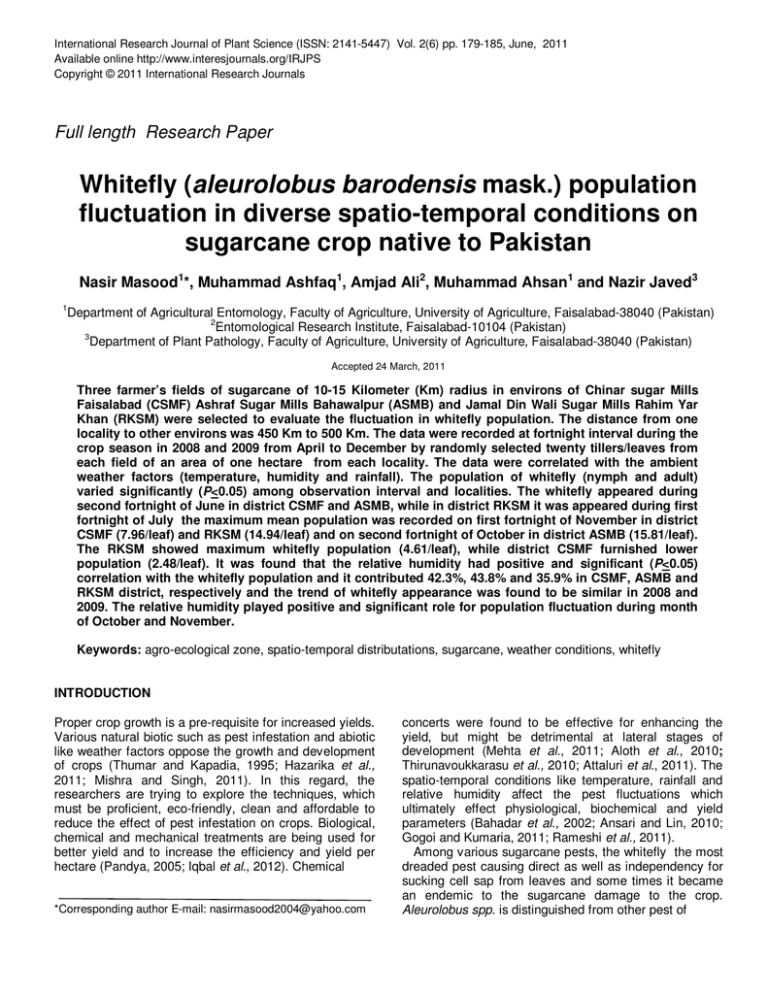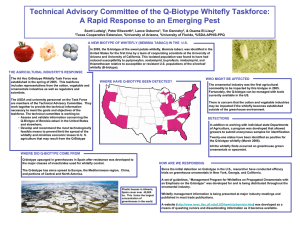Document 14258289
advertisement

International Research Journal of Plant Science (ISSN: 2141-5447) Vol. 2(6) pp. 179-185, June, 2011 Available online http://www.interesjournals.org/IRJPS Copyright © 2011 International Research Journals Full length Research Paper Whitefly (aleurolobus barodensis mask.) population fluctuation in diverse spatio-temporal conditions on sugarcane crop native to Pakistan Nasir Masood1*, Muhammad Ashfaq1, Amjad Ali2, Muhammad Ahsan1 and Nazir Javed3 1 Department of Agricultural Entomology, Faculty of Agriculture, University of Agriculture, Faisalabad-38040 (Pakistan) 2 Entomological Research Institute, Faisalabad-10104 (Pakistan) 3 Department of Plant Pathology, Faculty of Agriculture, University of Agriculture, Faisalabad-38040 (Pakistan) Accepted 24 March, 2011 Three farmer’s fields of sugarcane of 10-15 Kilometer (Km) radius in environs of Chinar sugar Mills Faisalabad (CSMF) Ashraf Sugar Mills Bahawalpur (ASMB) and Jamal Din Wali Sugar Mills Rahim Yar Khan (RKSM) were selected to evaluate the fluctuation in whitefly population. The distance from one locality to other environs was 450 Km to 500 Km. The data were recorded at fortnight interval during the crop season in 2008 and 2009 from April to December by randomly selected twenty tillers/leaves from each field of an area of one hectare from each locality. The data were correlated with the ambient weather factors (temperature, humidity and rainfall). The population of whitefly (nymph and adult) varied significantly (P<0.05) among observation interval and localities. The whitefly appeared during second fortnight of June in district CSMF and ASMB, while in district RKSM it was appeared during first fortnight of July the maximum mean population was recorded on first fortnight of November in district CSMF (7.96/leaf) and RKSM (14.94/leaf) and on second fortnight of October in district ASMB (15.81/leaf). The RKSM showed maximum whitefly population (4.61/leaf), while district CSMF furnished lower population (2.48/leaf). It was found that the relative humidity had positive and significant (P<0.05) correlation with the whitefly population and it contributed 42.3%, 43.8% and 35.9% in CSMF, ASMB and RKSM district, respectively and the trend of whitefly appearance was found to be similar in 2008 and 2009. The relative humidity played positive and significant role for population fluctuation during month of October and November. Keywords: agro-ecological zone, spatio-temporal distributations, sugarcane, weather conditions, whitefly INTRODUCTION Proper crop growth is a pre-requisite for increased yields. Various natural biotic such as pest infestation and abiotic like weather factors oppose the growth and development of crops (Thumar and Kapadia, 1995; Hazarika et al., 2011; Mishra and Singh, 2011). In this regard, the researchers are trying to explore the techniques, which must be proficient, eco-friendly, clean and affordable to reduce the effect of pest infestation on crops. Biological, chemical and mechanical treatments are being used for better yield and to increase the efficiency and yield per hectare (Pandya, 2005; Iqbal et al., 2012). Chemical *Corresponding author E-mail: nasirmasood2004@yahoo.com concerts were found to be effective for enhancing the yield, but might be detrimental at lateral stages of development (Mehta et al., 2011; Aloth et al., 2010; Thirunavoukkarasu et al., 2010; Attaluri et al., 2011). The spatio-temporal conditions like temperature, rainfall and relative humidity affect the pest fluctuations which ultimately effect physiological, biochemical and yield parameters (Bahadar et al., 2002; Ansari and Lin, 2010; Gogoi and Kumaria, 2011; Rameshi et al., 2011). Among various sugarcane pests, the whitefly the most dreaded pest causing direct as well as independency for sucking cell sap from leaves and some times it became an endemic to the sugarcane damage to the crop. Aleurolobus spp. is distinguished from other pest of 180 Int. Res. J. Plant Sci. Table 1: Correlation coefficient values (r) between population of whitefly and weather factors at various localities of sugarcane growing areas of the Punjab, Pakistan during 2008 Weather Factors Max. Temp (Co) o Min Temp (C ) o Av. Temp (C ) Relative Humidity (%) Rainfall (mm) Localities Faisalabad -0.364 -0.447 -0.422 Bahawalpur -0.195 -0.220 -0.226 Rahim Yar Khan -0.231 -0.202 -0.227 -0.226 -0.219 -0.244 0.440 0.270 0.211 0.303 * -0.465 -0.231 -0.151 -0.279 Average *Significant at P<0.05 sugarcane by it’s marked the crop. Population flare-up and reaches up to economic threshold level (10 per leaves/tillers) enormously under water logged condition and nitrogen deficient areas (Ahmed et al., 2004; Mann et al. 2006; Ansari et al., 2011). The adults of whitefly are small pale yellow about 3 mm long, ovate in outline with black and grey coating on the body. Only the nymphs are found on the underneath of the leaves and cause the damage by sucking the cell sap and it became pale and dry. Ultimately, the leaves turn black in lieu of the development of fungus and render the crop unfit as fodder (Parsana et al., 1995; Mann and Singh, 2003; Ansari et al. 2007). Sugarcane (Saccharum offecinarum L) is an important cash crop in Pakistan and grown through out the tropical and subtropical parts of the world (Khaliq, 2002). Sugarcane plant during their different growth stages are attacked by a number of insect which are major constraints in getting higher yield (Aonnymous, 2006; Iqbal et al. 2012). Due to heavy infestation of the pests, serious decline (86.00% reduction in cane yield; 1.4-1.8% reduction in sugar recovery) in production has been reported (Anonymous, 2006). The triviality of whitefly as economic pests seems to expanding continuously and insect damage crop by extracting large quantities of phloem sap which can result in greater than 50% yield reduction. The honey dew excreted by this insect serves as a medium for sooty mold and fungi, for example, Capnodium species, discolor part of the plants used for food. A few species of whitefly serves as vectors of several economically important viral plant pathogens (Byrne and Bellows, 1991). The estimated area under sugarcane cultivation in Pakistan is 966 thousand hectares with an annual production of 47244 thousand metric tones. The per hectare yield in Pakistan is 48.907 metric tones which is very low as compared to many sugarcane growing countries such as Columbia (136.2700), Egypt (121.000), Australia (85.000), USA (66.179), Indonesia (81.389), Brazil (72.849), India (61.952), South Africa (69.631) and Philippine (81.579) (Anonymous, 2006). Due to high reproduction as well as damage potential, sucking cell sap and acquired resistance to most commonly used insecticide, the control of whitefly has become increasingly difficult with insecticide alone. Moreover, the indiscriminate use of these insecticides since past few decades has led to many serious problems like resurgence of minor pests, destruction of beneficial fauna and environmental pollution. There is a need to explore alternative methods to reduce the use of pesticides and their adverse effects on environment and human health. For this purpose integrated control strategy for sustainable management of this pest is inevitable (Jena and Nayak, 1994; Thumar and Kapadia, 1994). So far, despite the sugarcane importance, little attention has been given for the improvement of this crop native to Pakistani land irrespective to pest infestation. In this regard, the present research work was planned to study the spatio-temporal effect on whitefly population fluctuation in sugarcane at different ecological regions (RKSM, ASMB and CSMF during 2008 and 2009), whether, to know which factor is favorable for population fluctuation of whitefly attack under different temperature, relative humidity and rainfall conditions (Table 1). MATERIALS AND METHODS Experiments were conducted in farmer’s fields around sugar Mills area (CSMF, ASMB, and RKSM). Three farmer’s fields of sugarcane, each around RKSM K, ASMB and CSMF were selected (Figure 1). The population was recorded in vicinity of sugar mills from 10-15 km radius for population count of whitefly (nymph and adult) throughout the crop season at fortnightly interval from April to December in 2008 and 2009 by randomly selected twenty tillers/leaves from each field of an area of one hectare from each locality. Statistical analysis The data were analyzed statistically following RCBD in three replicate and means were compared by DMR Test (P=0.05) to find the significant difference among various localities. The data were also processed for simple correlation (r). The combined effect of the factors like temperature, relative humidity and rainfall on the Masood et al. 181 Figure 1. showing the agro-ecological zones of Punjab, Pakistan, which were studies for whitefly population fluctuation on sugarcane crop population of whitefly was measured by using a multiple Linear Regression Equation (Table 4). Y = a+b2x2 +b2+2+b2x2 ………… where population of the insects was taken as the Response Variable (Y) and the following ‘predictor’ variables were used to represent the equation. X1= Maximum temperature for every 15 days, X2 = Minimum temperature for every 15 days X3 = Average mean temperature for every 15 days, X4= Average relative humidity for every 15 days and X5= Total rainfall (mm) for every 15 days RESULTS The result shows that the different spatio-temporal conditions affected the whitefly population. The population of whitefly was found significant at 95% confidence interval of mean at different dates of observation, locality and population fluctuation of whiteflies is given in (Table 2). The means difference was compared by DMR Test (P=0.01). It is evident from the results that population of whitefly appeared on second fortnight of June in district CSMF and ASMB and on first fortnight of July in district RKSM (Table 3 and 4). The results of 2008 and 2009 regarding whitefly population were found non- significant at 95% confidence interval of mean (Table 3 and 4). In district CSMF, an increasing trend was observed from second fortnight of June to first fortnight of November and the population reached to its peak level of 7.96 /leaf whitefly (nymph and adult). The increasing trend of population count in district ASMB was started from second fortnight of June to second fortnight of October and the population reached to its peak level with 15.81/leaf whitefly (nymph and adult). Similarly, in District RKSM, the population started from second fortnight of July and reached to its peak level on first fortnight of November i.e. 16.94/leaf whitefly (nymph and adult) after gradual increase. In general, the decreasing trend was observed thereafter on the subsequent dates of observation in each district in comparison of their respective higher population. In first fortnight of December the population level was recorded to be 3.09, 2.43 and 2.08/leaf whitefly (nymph and adult) in districts CSMF, ASMB and RKSM, respectively and after that there was no significant variation. On an average basis, RKSM District showed maximum population i.e. 4.61/leaf (nymph and adult) and this difference was also found significant versus districts CSMF, ASMB and CSMF District showed minimum population i.e. 2.48/leaf whitefly (nymph and adult) and also showed significant difference with the population trend of other districts irrespective ASMB to lowest population. The population of whitefly was recorded to be 3.89/leaf in district ASMB which was intermediate trend to other districts. The multiple linear regression analysis along with coefficients of determination (R2) between population of 182 Int. Res. J. Plant Sci. Table 2. Analysis of variance of the data regarding whitefly population in different district of the Punjab at various farmers’ fields during 2008 Source Variance of Replications Dates of Observation (D) Districts (D) DXD Error D.F. F. Value Probability 2 11.42 ** 0.00 15 107.80 ** 0.00 2 30 94 34.41 ** 6.55 ** 0.00 0.00 CV = 34.93% ** = Sgnificant at P<0.01. D.F=Degree of freedom D= Districts D=Dates of observations Table 3. Means comparison of the data regarding whitefly population in different districts of the Punjab, Pakistan at various farmer’s fields during 2008 Dates Observation of Month 2nd fortnight April st 1 fortnight May 2nd fortnight May st June 1 fortnight 2nd fortnight June st July 1 fortnight 2nd fortnight July st 1 fortnight August 2nd fortnight August st September 1 fortnight 2nd fortnight September 1st fortnight October nd 2 fortnight October 1st fortnight November nd 2 fortnight November 1st fortnight December Means (LSD= 0.51, SE=0.18) Interaction (LSD=2.07, SE=0.73) Means LSD=1.19 SE=0.42 Faisalabad Bahawalpur Rahim Yar Khan 0.00 o 0.00 o 0.00 o 0.00 o 0.08 o 0.10 o 0.16 o 0.73 no 2.33 klmno 3.21 ijklm 4.67 ghijk 5.59 ghi 6.87 fg 7.96 ef 4.88 ghij 3.09 jklmn 2.48 c 0.00 o 0.00 o 0.00 o 0.00 o 0.06 o 0.62 o 0.84 mno 0.61 o 1.99 lmno 4.70 ghijk 7.95 ef 12.53 cd 15.81 ab 9.54 e 5.10 ghij 2.43 klmno 3.89 b 0.00 o 0.00 o 0.00 o 0.00 o 0.00 o 0.20 o 0.12 o 2.12 lmno 4.28 hijkl 5.72 fgh 9.19 e 12.28 d 14.52 bc 16.94 a 6.24 fgh 2.08 lmno 4.61 a 0.00 f 0.00 f 0.00 f 0.00 f 0.05 f 0.31 f 0.37 f 1.15 f 2.87 e 4.54 d 7.27 c 10.13 b 12.40 a 11.48 a 5.40 d 2.53 e The similar letters in columns are presenting significantly different by DMR Test at P = 0.05. whitefly and weather factors (temperature, rainfall and humidity) at different localities is given (Table5). The results showed that the second fortnight of October conditions of temperature, rainfall and humidity have strong relation with the population of whitefly in three 2 localities. The district ASMB showed the R value of 43.8 2 followed CSMF and RKSM with R value of 42.3 and 35.7. The cumulative affect of all localities was also found higher at second fortnight of October. In general, the significant decreasing trend was observed there after on the subsequent dates of observation and reached to a level on second fortnight of November. From these results it was found that the period from last week of September to third week of October was the most Masood et al. 183 Table 4. Means comparison of the data regarding whitefly population in different districts of the Punjab, Pakistan at various farmer’s fields during 2009 Dates of Month Observation 2nd fortnight April 1st fortnight May 2nd fortnight May st 1 fortnight June 2nd fortnight June st 1 fortnight July nd July 2 fortnight st 1 fortnight August nd August 2 fortnight September 1st fortnight nd 2 fortnight September st October 1 fortnight nd 2 fortnight October 1st fortnight November 2nd fortnight November 1st fortnight December Means (LSD= 0.52, SE=0.17) Interaction (LSD=2.07, SE=0.73) Faisalabad Bahawalpur 0.00 o 0.00 o 0.00 o 0.00 o 0.00 o 0.00 o 0.00 o 0.00 o 0.08 o 0.06 o 0.11 o 0.62 o 0.15 o 0.85 mno 0.72 no 0.62 o 2.32 klmno 2.00 lmno 3.19 ijklm 4.72 ghijk 4.66 ghijk 7.96 ef 5.57 ghi 12.55 cd 6.86 fg 15.82 ab 7.98 ef 9.52 e 4.89 ghij 5.09 ghij 3.10 jklmn 2.41 klmno 2.48 c 3.90 b Rahim Yar Khan 0.00 o 0.00 o 0.00 o 0.00 o 0.00 o 0.20 o 0.11 o 2.11 lmno 4.26 hijkl 5.69 fgh 9.20 e 12.26 d 14.51 bc 16.96 a 6.26 fgh 2.11 lmno 4.6 a Means LSD=1.18 SE=0.43 0.00 f 0.00 f 0.00 f 0.00 f 0.05 f 0.31 f 0.38 f 1.16 f 2.89 e 4.56 d 7.26 c 10.15 b 12.41 a 11.46 a 5.38 d 2.51 e The similar letters in columns are presenting significantly different by DMR Test at P = 0.05. Table 5. Multiple linear regression analysis along with coefficients of determination (R2) between population of whitefly and weather factors at different localities Regression Equation Y= Y= Y= Y= Y= Y= Y= Y= Y= Y= Y= Y= Y= Y= Y= Y= Y= Y= Y= Y= Faisalabad 4.478 – 0.6213 x1 9.0723 – 0.08483 x1 – 1.009 x2 9.4567 – 11.529 x1 – 15.649 x2 + 25.978 x3 - 24.4645 + 8.885 x1 + 20.345 x2 – 27.870 x3 + 1.689 x4 - 22.328 + 9.827 x1 + 20.484 x2–29.048 x3+1.5711 x4 – 0.0581 x5 Bahawalpur 3.132 – 0.2909 x1 5.3584 – 0.1151 x1 – 0.4999 x2 11.5766 + 11.852 x1 + 14.612 x2 -28.347 x3 - 31.1338 – 10.722 x1 – 9.131 x2 + 19.600 x3 + 3.7246 x4 - 40.0518 – 16.571 x1 – 16.106 x2 + 33.015 x3 + 4.437 x4 – 0.2007 x5 Rahim Yar Khan 3.3570 – 0.298 x1 4.4613 – 0.2223 x1 – 0.2412 x2 4.6309 – 0.1906 x1 – 0.1098 x2 – 0.2045 x3 - 6.4614 – 0.1911 x1 + 0.764 x2 – 3.1016 x3 + 2.5604 x4 - 10.29299 – 0.3182 x1 + 0.2142 x2 – 2.9148 x3 + 3.4166 x4 – 0.2606 x5 Cumulative 3.2624 – 0.3205 x1 4.7742 – 0.2038 x1 – 0.3416 x2 4.916 – 0.1068 x1 – 0.1176 x2 – 0.3601 x3 0.5581 – 0.2097 x1 + 0.1991 x2 – 0.8883 x3 + 0.7058 x4 0.9128- 0.2558 x1– 0.2386 x2 – 0.320 x3 + 0.6605 x4 – 0.0905 x5 X1= Maximum Temperature oC X2 =Minimum Temperature oC X3 = Average Temperature oC X4 = Relative Humidity (%) X5 = Rainfall (mm) R2 Role (%) 0.133 0.201 0.219 0.642 0.658 13.3 6.8 1.8 42.3 1.6 0.038 0.051 0.126 0.564 0.715 3.8 1.3 7.5 35.9 15.1 0.053 0.059 0.059 0.418 0.609 5.3 0.6 0.00 43.8 19.1 0.051 0.059 0.061 0.244 0.279 5.1 0.8 0.2 18.3 3.5 184 Int. Res. J. Plant Sci. favorable period for the production of whitefly. DISCUSSION After recording the data on whitefly population and its comparison with spatio-temporal weather condition showed a significant difference. It was evident from the results that in district CSMF and ASMB, the population of whitefly was appeared during the second fortnight of June while in district RKSM it was appeared during the first fortnight of July. An increasing trend was observed thereafter in all the districts and reached to maximum of 7.96 and 16.94 individuals per leaf during first fortnight of November in districts CSMF and RKSM, respectively. Furthermore, it was observed that the population was fluctuated towards maximum trend from first fortnight of September to second fortnight of November. However, first fortnight of November showed the maximum peak in district CSMF and RKSM, whereas in district ASMB the second fortnight of October was found to be very crucial period for the development of the pest. Keeping in view the relationship of weather factor (temperature, rainfall and humidity) on population fluctuation of the whitefly, it was observed that the relative humidity played a significant and positive role and contributed 42.3%, 43.8%, 35.9% and 18.3% in population fluctuation on the population of whitefly in the spatio-temporal conditions of CSMF, ASMB and RKSM on cumulative basis, respectively. It is well known that the weather conditions are considered to be the forecast of pest fluctuation. The pest requires a critical condition for their fluctuation, because the critical weather condition affects the life cycle phases (biology) of pest. A study on the occurrence and the abundance of whitefly reveal that infestation commenced from mid July (1.50 nymphs/ cm2 per leaf) and reached to a peak (3.93 nymphs cm2 per leaf) in the first week of October and this study was found to be correlated with (Thumar and Kapadia, 1995) who reported that the nymph population was highest in the period between mid September to November (3.13 to 3.95 nymphs per cm2. The average nymphal and pupal population in a year ranged from 0.95-17.05 and 0.63-13.25, respectively. The peak activity was observed during July to December for nymphs and June to November for pupae and our finding were also found comparable with (Pandya, 2005) that the average population of nymph and pupae of sugarcane whitefly ranged from 0.95 to 17.05 and 0.63 to 2 13.25 cm per leaves, respectively during different months of the year. The peak activity of nymph was during July to December while that of pupae during June to November. CONCLUSION The population was appeared during second fortnight of June in district CSMF and ASMB, while in district RKSM appeared during first fortnight of July. The trend was found to be similar in 2008 and 2009, which might be due the similar weather condition, because the humidity was found positively correlation with whitefly population. The peak population was recorded on first fortnight of November to second fortnight of October all districts. On an average basis, the district RKSM showed maximum population of whitefly, while district CSMF furnished lowest population. Relative humidity had a positive and significant correlation with the whitefly population and it boosted up the population of whitefly up to 42.3%, 43.8% and 35.9% in CSMF, ASMB and RKSM, respectively. Sugarcane growers be vigilant during month of October and November for whitefly attack because humidity raise during these months. ACKNOWLEDGEMENTS Author would like to thanks, Higher Education Commission (HEC) of Pakistan for providing the financial support in carrying out this research work (PIN 074-0755AV4-219). REFERENCES Ansari MI, Lin TP (2011). Subcellular localization of Arabidopsis thylakoid lumen 18.3 protein (TLP 18.3). Inter. Res. J. Plant Sci. 2(1): 6 -9. Attaluri S, Sangakkara UR, Costa WA (2011). Physiological adaptability of sweetpotato (Ipomoea batatas) genotypes as influenced by seasons with emphasis on orange-fleshed sweetpotato. Indian. J. Agric. Sci. 81(3): 33–7. Aloth ST, Kubala G, Misangu C, Mwatawala W (2010).Efficacy of protectants against maize weevils and the larger grain borer for stored maize .Inter. Res. J. Plant Sci. 1(6): 150-154. Ansari AH, Khanzada G, Arain AR (2007). Insect pest associated with sugarcane crop and their control. Pak. Sugar. J. July-September. Anonymous (2006). Economic survey. Govt. of Pak. Finance division. Economic Advisory wing, Islamabad, pp. 14. Ahmed A, Suhail A, Abdin ZU, Iftikhar S, Zahoor K (2004). Biodiversity of insect associated with sugarcane crop in Faisalabad. Pak. Entomol. 26(1): 65-69. Byrne N, Bellows D (1991). Studies on Whitefly biology. Ann. Rev. Entomol. 36(5): 431-457. Gogoi K, Kumaria S (2011). Callus-mediated plantlet regeneration of Ocimum tenuiflorum L . using axillary buds as explants. Inter. Res. J. Plant Sci. 2(1):1-5. Hazarika S, Ganeshamurthy AN , Sakthivel T (2011). Long-term management effects on spatial variability of quality characteristics of soils under guava (Psidium guajava) and sapota (Manilkara achras) orchards in south-western climate of India. Indian J. Agric. Sci. 81(1): 119–24. Iqbal M, Haq Z, Jamil Y, Ahmad MR (2012). Effect of pre-sowing magnetic treatment on growth and chlorophyll content of pea (Pisum sativum L.). Int. J. Agrophysics. (Accepted). Mehta S, Bedi S, Vashist KK ( 2011). Performance of winter maize (Zea mays) hybrid to planting methods and nitrogen levels. Indian J. Agric. Sci. 81(1): 50–4. Mishra JS, Singh VP (2011). Effect of tillage and weed control on weed Masood et al. 185 dynamics, crop productivity and energy-use efficiency in rice (Oryza sativa) based cropping systems in Vertisols. Indian J. Agric. Sci. 81: 129–33 Mann RS, Suri KS, Sharma S (2006). Population dynamics of insect pests of sugarcane in Punjab. Indian J. P. Pro. 34(2): 198-201. Mann RS, Singh K (2003). Screening of sugarcane genotype for their reaction against sugarcane whitefly, ( Aleurolobus barodensis Mask.). Indian Sugar J. 23: 110-111 Pandya HV (2005). Population status and management of sugarcane whitefly (Aleurolobus barodensis Mask.) in Gujrat. Coop. Sugar. 36(1): 479-482. Ramesh G, Shivanna MB, Santa Ram A (2011). Interactive influence of organic manures and inorganic fertilizers on growth and yield ofkalmegh. (Andrographis paniculata Nees.). Inter. Res. J. Plant Sci. 2(1): 16-21 Thirunavoukkarasu M, Panda PK, Nayak P, Behera PR, Satpathy GB (2010 ).Effect of media type and explant source on micro propagation of Dalbergia sissoo Roxb. An important multipurpose forest tree. Inter. Res. J. Plant Sci. 1(6): 155-162. Thumar RK, Kapadia MN (1995). Biology and population dynamics of sugarcane whitefly, Aleurolobus barodensis Maskell under Junagadh conditions of Gujrat. Gujrat Agric. Univ. Res. J. 20(1): 103-107. Vega R, Sánchez-GI, Guadarrama P, González IS, Silvia CA (2011). International Pattern of root colonization by arbuscular mycorrhizal fungi in Verbesina virgata and their effects on plants growth and leaf physical attributes. Int. Res. J. Plant Sci. 2(1): 10-15.






